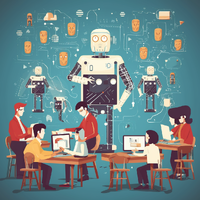AI in the classroom - How are teachers using it?
Author: Gerard Alford Date Posted:5 June 2023

Reducing teacher work loads and personalising student learning experiences, explore the myriad ways Australian educators are harnessing AI.
AI in the classroom
How are teachers using it?
Evidence suggests that Artificial Intelligence (AI) is more likely to replace tasks rather than jobs. James Bessen from Boston University cites that of the 270 occupations listed on the US census in 1950, there is just one occupation that no longer exists due to automation: the elevator operator.
So, if technology is more about changing jobs rather than replacing them, are we seeing any change in schools? Is there any evidence where AI, such as ChatGPT and models like it have changed some of the tasks we perform at our schools?
The potential for relieving teachers of hours of work by using AI-powered tools is real and present. AI tools are certainly capable of drafting a valuable one-hour lesson plan in just a few moments, creating tailored illustrations (the image for this article was generated by AI) and completing routine administrative tasks, potentially freeing up teachers’ valuable time.
In practice, how can we use AI to reduce teacher workloads so we can devote more time to our teaching pedagogy, in improving our lesson delivery, providing feedback and individual time to our students, and refining our lesson content?
Changing teaching practices with AI?
So, what can AI do in schools? Here are a few things:
- Track student attendance using scanners / facial recognition. The attendance data can automatically communicate with parents, identify patterns of absenteeism and alert teachers and administrators of potential issues.
- Generate quiz questions such as MCQ’s, True / False statements
- Design draft assessment rubrics
- Generate exemplars
- Create lesson plans
- Produce writing ideas, such as introductory lines, topic sentences and headings/themes
- Suggest improvements to programming code and alternate solutions.
Introducing AI into classrooms isn't without its challenges. Significant issues such as data privacy, accessibility and the risk of over-reliance on technology are noteworthy concerns. We are still at the dawn of understanding the full potential of AI in education.
Let’s continue the discussion!
A Call to Educators
Now, let's hear from you.
How are you using AI in your classrooms?
How has it impacted your teaching and your students' learning?
Your experiences and insights can provide valuable guidance for those considering ways to integrate AI into their teaching practices. The future of education is being written and we'd love to hear your thoughts about the challenges and benefits these tools may yield. ITC has established a blog to share ideas.
Please feel free to leave a comment below to share your thoughts and feelings on this subject. We would appreciate your contribution.
Comments (1)
Lesson Plans
7 June 2023My experience is that AI, and in particular, ChatGPT produced very solid lesson plans, usually is the format of Lesson Opening, Lesson Middle and Lesson Consolidation. Of course, you can change this format, but it is well established structure. At this stage, there seemed to be little knowledge of integrating cooperative learning tools, even the common Think:Pair:Share. I would strongly suggest you add these in, otherwise you have largely unstructured group activities. Of course, the lesson is only as good as the information you provide to the AI tool. This means inputting explicit tasks (using those cognitive verbs; explain, compare, analyse, etc). A personal preference of mine is usually attach thinking tools to the task, which it does not tend to do. However, this can easily be inserted.
